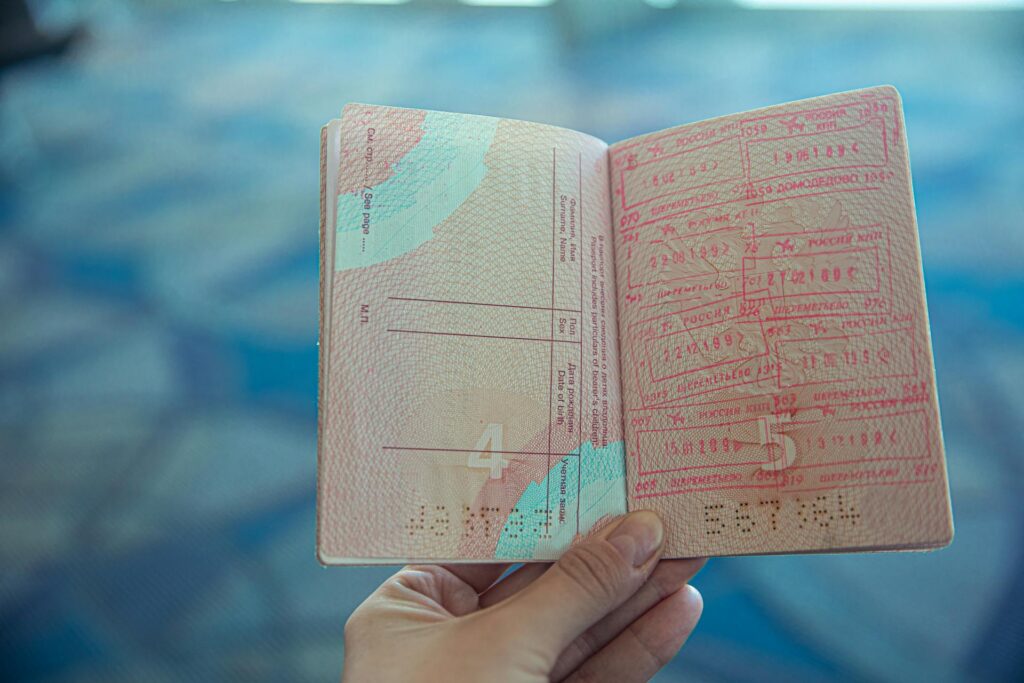A complete guide on how to plan a trip to Europe
From your visa to travel tips, learn how to plan your trip to Europe with our complete guide covering the basics and additional info for your dream trip
Planning a trip to Europe takes more than choosing the places you visit. For example, did you know that not all European countries are part of the European Union? That changes everything regarding how long you can stay and entry requirements, like a visa!
That’s why we prepared a guide on planning a trip to Europe, where we explore everything you need to remember before and during your trip.
Check for visa requirements before your trip
Currently, US citizens visiting Europe can access and stay in most EU countries up to 90 days without a visa.
The main requirements are a valid passport for up to six months after the travel date, a flight ticket, and enough money to cover your expenses. Plus, a hotel/Airbnb reservation might be requested upon entry.

But there are some things to consider:
- Are you traveling to a non-European Union country or outside the Schengen Area? If so, entry requirements might vary from country to country.
- Check if the country or countries you visit are within the Schengen Area, as you can stay for up to 90 days.
- Starting mid-2025, all travelers must complete the European Travel Information and Authorization System (ETIAS) 30 days before arrival.
But since the Schengen Area is a bit complicated to understand, here are some additional details.
Understanding Schengen stay limits for non-EU tourists
- You can stay in the Schengen Area for up to 90 days within a 180-day period.
- If you hit the 90-day stay, you must leave and can return after 180 days.
- Your 90 stay days are calculated using a 180-day window. The Schengen Calculator and similar apps can help you calculate this limit.
- You can visit a non-Schengen European country, like Serbia or the UK, and stay there legally before you return to any Schengen country.
It’s important to note that fines, deportations, and potential bans can apply if you break the immigration rules.
Also, if you’re moving to a non-Schengen country, remember to double-check the entry requirements.
Plan your travel dates and how long you plan to stay
When planning a trip to Europe, check what the weather will be like on your travel dates as the continent goes through the four seasons.
Chances are you don’t want to walk around Rome in the summer heat, or perhaps it’s the other way around, and you don’t want to freeze while walking close to La Gran Via in Madrid.
Here’s a quick breakdown of the seasons in Europe:
- Winter: November to March
- Spring: April to May
- Summer: June to September
- Autumn: September to November
While some cities have fewer visitors from October to April, major cities like Paris, Rome, or Athens are always packed no matter the season.
Also, research the local popular events, like the Venice Festival or Christmas markets, when planning your trip. Experiencing them is unforgettable, but it also means dealing with crowds, so they are important depending on whether you want to be there for them or plan around them.

Lastly, plan to stay at least two weeks to experience an authentic European vacation. But if possible, one month for your first trip will be spent visiting most major cities.
Buy your plane tickets
Buying your flight tickets in advance is an ideal way to save money when planning a trip to Europe.
Consider that flights will have different pricing depending on where you’re leaving and your chosen dates. Here are some examples of an off-season trip:
- Prices to fly from the Denver Airport to London range from $608 to $765 for a round-trip.
- Prices to fly from the Boston Logan Airport to Madrid range from $630 to $821 for a round-trip.
- Prices to fly from the Miami Airport to Madrid range from $552 to $727 for a round-trip.
On the other hand, if you plan to make a summer trip to Europe, a round-trip ticket can easily cost between $985 and $1.280.
Lastly, chances are you’re considering a multi-city trip to Europe. For example, when traveling around Europe, consider buying your tickets in advance with airlines like Ryanair or WizzAir to save money, but remember these have some luggage restrictions and sometimes don’t fly directly to the main airports.
Another option is to use airlines like Iberia, Lufthansa, or Air France for higher prices and better service.
Find the best way to exchange your money
Since you’re traveling from the US to Europe, you’ll need to exchange your USD for EUR to have some pocket money handy for things like a walking tour, public toilets, laundromats, or throwing a coin on the Trevi Fountain.

You can find different currency exchange companies within major airports, making things easier during your trip, but these usually offer a low exchange rate. Instead, wait until you head over downtown and find better exchange rates!
Lastly, while Euros are accepted on most European destinations, if you’re visiting the United Kingdom, Romania, Poland, Czech Republic, Sweden, Bulgaria, or Hungary, you’ll need to exchange your USDs for their local currency.
If you have doubts about using the Euro, you can visit the European Union Site to find the full list of countries accepting this currency.
Decide where you want to go
When choosing European destinations, consider what you want to experience during your trip.
Since you can easily move from one country to another, you can visit different iconic landmarks in no time. But is that everything you want to do?
- Historical landmarks: Every European country has its own rich history, but countries like Italy and Greece are particularly famous for their iconic landmarks, like the Parthenon and the Colosseum.
- Beaches: Spain, Portugal, and Greece are ideal destinations for a summer trip, especially if you consider cities and islands like Mykonos, Tenerife, and the Algarve.
- Outdoor activities: From the Alps to the icy landscapes in Iceland, outdoor activities are ideal for several European destinations if you’re interested in hiking and connecting with nature.
- Museums: Europe has some of the most beautiful museums in the world. The Uffizi Galleries, Vatican Museums, Louvre Museum, Rijksmuseum, and many others are great places to visit.
These are just the tip of the iceberg, as there’s much more to do and visit in Europe, so take your time to consider where to go based on what you want to experience.
Create a travel itinerary for each city and country you visit
Planning to visit the main attractions isn’t enough when traveling to Europe. You can go to Paris and go further than the Eiffel Tower, like taking a tour of the Catacombs, or if you’re going to Madrid, consider visiting the city’s outskirts as well.

But, besides creating a travel itinerary based on where you want to go, don’t forget to add essential information like:
- What are the closet’s historical landmarks, museums, sightseeing locations, restaurants, and other interesting places you can visit?
- What’s the best way to move around the country/city? Are there enough train routes, good public transportation, and mobility apps like Uber?
- If you’re visiting isolated places like mountains, look for local tour agencies. A guide will ensure a proper experience.
- During your planning process, don’t forget to add how much you can spend on each country/city you’re visiting.
- Always add the flight or train travel dates to avoid surprises in your Europe itinerary plan.
Choose where to stay: Hotel, hostel, or Airbnb
When planning your European trip, you must consider where you’ll stay. You might want to stay in a hotel or Airbnb based on your itinerary.
Hotels are a great option if you’re staying in the same city for long periods of time. The same goes for specific Airbnb locations, because resting and feeling comfortable is also part of the experience.
But if you’re visiting a new city and only staying for a night, there are other options to consider, especially if you’re on a budget. You can stay in a hostel with a small group of people, stay in a cheaper hotel room or Airbnb, and then leave the other day.
Either way, you must book your hotel or Airbnb room in advance. The best options are quickly booked, and chances are you don’t want to stay two hours from the city for a good trip.
Tip: You can try apps like Housesitting or Couchsurfing, where you can get free accommodations for short-term stays, and you can later host other travelers back in the US as well.
Travel tips to visit Europe
Now that we know how to plan a trip to Europe, we’re close to our dream trip, but there are some additional things to consider before planning your international travel packing list and jumping on the next European flight.
- Consider seasons: Europe can be extremely hot or cold, affecting the activities you can do during your trip. Consider seasons when traveling during your planning process, as it will also help you choose what to pack for Europe and always check the weather forecast.
- Book mobility and lodging in advance: The earlier you buy your plane or travel tickets, the cheaper they’ll be, and the same goes for lodging. This is also important for specific services, like NightJet, where you must book several months in advance.
- Respect local culture in each country: Each country has its own social rules, like traffic rules, religion, and politics, which you must respect during your entire trip. Also, it’s better to avoid discussing religion and politics in specific countries, like the Balkan countries.
- Look for dates and festivities/events to experience them: Europe has many things to experience, like the Tulip Season, which takes place from late March to mid-May, Oktoberfest in October, or Sanfermines in July, so check the calendar to find the best local activities to enjoy.
- Use Google Maps for guidance: While public transportation is good in Europe, you’ll walk a lot, as many European countries have important places to visit nearby. But remember that you might face issues with Google Street View in rural areas in countries like Bosnia and Herzegovina.
- Avoid data roaming fees: Depending on your mobile carrier, you can easily spend $10/day for EU roaming in Europe. That’s a lot, especially if you’re staying for more than a week, so consider other options like European eSIMs.
- Prepare your luggage: This will vary depending on the season and your travel plans. Visiting the Alps? Make sure to pack a proper coat. Planning to walk a lot? Pack your best running shoes.
- Get travel insurance: Travel insurance is a must, so make sure you have one before your trip to Europe. It can be a very convenient solution if something happens.
Get a Holafly eSIM for Europe with unlimited data for your trip
The last thing you need for the ideal trip to Europe is an internet connection. Whether you need it to buy museum tickets, move around using Google Maps, or even translate words into English, getting mobile internet in Europe is necessary.
However, using data roaming is expensive, and alternatives like pocket WiFi or SIM cards in Europe can be limited or be out of your budget; using an eSIM is a better solution.
With Holafly, you have two options for using your cell phone in Europe. One of them is using an eSIM for Europe, which starts at $6.90 per day and includes unlimited data for up to 90 days — with the daily price dropping to as low as $1.55 when you choose a longer plan.
However, if you fall in love with Europe and are a remote worker looking to stay a while longer, trying Holafly Connect is your best option.
Holafly Connect: The internet connection that travels with you
No more SIM swaps, surprise fees, or searching for a provider in every new country. With Holafly Connect, you get one eSIM that works across 130+ countries, renewing automatically every month so you’re always online. Here are the available plans:
- Unlimited data – Stay connected across borders with high-speed internet that will make digital nomads and remote workers very happy.
- 25 GB plan – Ideal for professionals who rely on video calls, work tools, and smooth browsing.
- 10 GB plan – A great option for need essential connection, but need it to be reliable and available.
Getting started is easy! Visit our Holafly Connect page, choose the plan that fits your needs, and activate it in seconds. Stay connected wherever you go!





 Language
Language 


















 No results found
No results found






